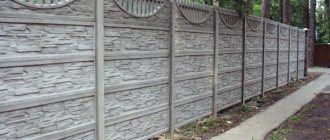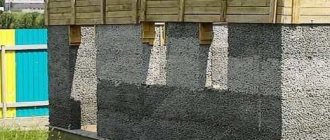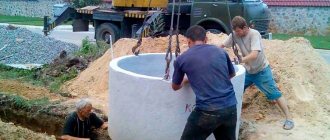A concrete septic tank is a concrete structure in which sewage is collected and treated. Depending on the complexity of the septic tank structure, the wastewater from it can be pumped out or undergo several stages of purification. The main purpose of the pit is to prevent soil contamination by chemicals contained in wastewater.
For a septic tank, ready-made concrete containers made according to one template can be used Source prostroyer.ru
A full-fledged multi-chamber septic tank consists of several compartments in which the stages of waste treatment occur:
- Compartment for primary accumulation of sewage water. This department receives wastewater from the house and is divided into elements heavier and lighter than water and primary clarification liquid. If the structure of the septic tank is single-chamber and does not provide for further waste treatment, then the collected wastewater is simply pumped out periodically.
- Oxygen-free compartment. The lack of oxygen promotes the proliferation of anaerobic organisms. In the process of vital activity, they decompose complex substances into simple ones: fats, carbohydrates and household chemicals into gas, water and sludge.
- Oxygen compartment. In this section, microorganisms process substances that subsequently settle at the bottom.
- Water drainage. After all stages of purification, wastewater, clarified by approximately 70%, is discharged for soil post-treatment into a filtration field, from where it goes into the soil.
Construction of a concrete septic tank
This structure is erected from concrete rings. It is better to entrust the installation of such a sump to specialists. Failure to comply with technology can lead to consequences. It is better to divide the pit into several compartments, which will be connected by pipes.
Types of septic tanks:
- Single chamber
- Double chamber
- Three-chamber
The first type is a regular pit in which wastewater is simply collected. Waste is pumped out approximately once every 6 months. Proper operation will allow you to use septic tanks for many years.
Two- and three-chamber systems have a filter well with a monolithic bottom. Water is discharged through a drainage pipe. In such septic tanks, the water is purified better, since the well is not contaminated with solid particles.
A multi-chamber septic tank uses anaerobic bacteria that purify wastewater naturally Source remontik.org
Construction of a single-chamber septic tank
This type of sump consists of a pit in which walls are made of concrete rings or cast-in-place concrete. The bottom should be monolithic or consist of layers of sand and gravel. Water enters the pit, and after two days the heavy elements settle to the bottom. Gases exit through a special hole, and water is pumped out. Silt forms at the bottom, which is removed with a special pump. The size of the drainage pit depends on the number of people living in the house. The disadvantage of such a septic tank is its rapid filling.
A septic tank with one chamber usually requires pumping out wastewater with special equipment Source moya-banya.ru
See also: Catalog of companies that specialize in water supply and sewerage.
DIY manufacturing procedure
The process of building a septic tank from concrete rings takes place in several stages, which should be considered separately.
Calculation
According to current standards, there is 200 liters of wastewater per person per day (or 0.2 m3). When calculating a septic tank, a 3-day indicator is used. This means that 600 liters (or 0.6 m3) must be taken per person.
In addition, SNiP contains instructions on the duration of the wastewater in the settling tank - at least 14 days. Therefore, the minimum volume of the septic tank should be 2.8 m3 (at the rate of 0.2 m3 multiplied by 14 days).
The minimum volume is 2.8 m3 per person. This must be kept in mind, since many sources indicate it at least for a private house, without determining the number of inhabitants.
However, 200 liters per day is the maximum. In practice, one person consumes no more than 1000 liters (or 0.1 m3). Moreover, the operation of a septic tank requires careful use of water - an overfilled container will cause unclarified wastewater to enter the ground, which will cause extremely undesirable consequences. Therefore, manufacturers recommend using an indicator of 150 liters per person (0.15 m3) for calculation.
For an ordinary family of 4 people, it is recommended to use a septic tank with a volume of 6 m3. It is necessary to take into account that the volume of a septic tank is the sum of the volumes of all chambers.
The number of chambers is determined by the volume of wastewater. If it is 1 m3, one section (storage tank) is enough. Designs with 2 chambers cope well with quantities of up to 10 m3, but if there is more waste, a 3-chamber septic tank is needed.
There is also a method for calculating the volume of a septic tank based on the composition of the soil:
| Number of users | Volume of septic tank on sand m 3 | Volume on sandy loam m 3 | Volume on loam m 3 | Volume on clay m 3 |
| 1 | 4 | 7 | 10 | 15 |
| 2 | 7 | 12 | 17 | 22 |
| 3 | 10 | 15 | 20 | 25 |
| 4 | 15 | 20 | 25 | 30 |
| 5 | 15 | 20 | 25 | 30 |
| 6 | 17 | 23 | 27 | 35 |
| 7 | 20 | 25 | 30 | 35 |
Looking at this table, you can see that the indicators vary markedly. This is explained by the rate of absorption of wastewater into different types of soil. By choosing this calculation method, you can obtain a reserve of productivity required when increased load occurs (for example, the appearance of guests in the house or the addition of a family).
Choosing rings
The choice of rings is one of the most important stages in creating a septic tank. It is necessary to have a fairly clear idea of the sizes of products available on the market.
For a more visual representation of them, let's create a table:
| Model name | Dimensions (diameter/height/wall thickness, mm) | Volume (m3) |
| KS20.9 | 2000*900*100 | 2,83 |
| KS20.6 | 2000*600*100 | 1,89 |
| KS20.3 | 2000*300*100 | 0,94 |
| KS15.9* | 1500*900*90 | 1,59 |
| KS15.6* | 1500*600*90 | 1,06 |
| KS15.3* | 1500*300*90 | 0,53 |
| KS10.9* | 1000*900*80 | 0,71 |
| KS10.6* | 1000*600*80 | 0,47 |
| KS10.3* | 1000*300*80 | 0,24 |
| KS7.9 | 700*900*80 | 0,5 |
| KS7.3 | 700*300*80 | 0,16 |
The “*” sign in the names of the models means the presence of a locking connection between the structural elements of the ring.
When choosing a set of rings, you should keep in mind that the volume of the first chamber is about ¾ of the size of the second (and third, if there is one). This is explained by the difference in the composition of the wastewater - the receiving chamber contains all the organic matter, and the second contains only liquid. Most drawings or pictures online show two chambers of the same size and a large filtration well. In fact, only the receiving chamber is large, and the remaining sections are much smaller.
Choosing a location for installation
The selection criterion is the location of the filtration well. It should be at a distance:
at least 5 m from the house;- 30 m from the reservoir;
- 10 m from the river;
- 50 m from the well;
- 5 m from the road;
- 3 m from the fence (if there is a neighbor’s property behind it);
- 25 m from the water well;
- 3 m from fruit trees (or 5 m when using anaerobic bacteria).
Expert opinion
Levin Dmitry Konstantinovich
It can sometimes be extremely difficult to fulfill all the requirements. Moreover, many standards contradict each other. However, every effort should be made to ensure maximum compliance with all applicable requirements to reduce the risk of claims.
Excavation
First, the site is marked. The size of the pit is calculated based on the size and number of rings, as well as taking into account the distance between them (at least 50 cm). The depth of the pit is calculated by taking into account the dimensions of the rings, necks, as well as the gravel backfill layer.
The total size of the pit will be:
- in width - the diameter of the rings plus 50-70 cm on each side (for external treatment of concrete with waterproofing compounds);
- in depth - the height of the rings plus the height of the necks plus the thickness of the backfill layer (at least 30 cm).
- in length - the total diameter of all rings plus 50 cm between them, plus 50-70 cm gap between the outer rings and the walls of the pit;
What kind of septic tank is installed at your dacha?
Concrete ringsBarrels
To dig a pit you need an excavator. However, it is often necessary to hire workers for manual work. This is done if the equipment cannot enter the site. A layer of ASG or a mixture of expanded clay and sand is poured onto the bottom. The layer is compacted and carefully leveled horizontally.
Expanded clay with sand is preferable in regions with severe frosts - such backfill works as a heat insulator.
The base for the filtration well is constructed separately. Here the depth should be 80 cm greater than in the rest of the pit. The composition of the backfill also differs - first 40 cm of sand, then 40 cm of fine gravel, after which 30 cm of coarse crushed stone is poured. Each layer is pre-leveled and thoroughly compacted.
Installation of rings
To install the rings, lifting equipment is used - a truck crane or a hand hoist of sufficient power. First, the bottom is lowered, then the ring itself is installed on it (after first applying a layer of connecting compound around the perimeter). All rings are lowered in a similar way, after which all connections are thoroughly waterproofed.
During installation, it is necessary to ensure the accuracy of the position of the rings - there should be no distortions or displacement relative to the axis.
Overflow pipes
The installation of overflow pipes is carried out with a sequential decrease in the level of placement - the first should be located 20 cm below the level of the sewer pipe, the second - 20 cm below the first, etc. This will avoid the reverse flow of wastewater with a sharp increase in load.
Holes are made for installation of overflows. Then the overflows are inserted, the holes are concreted and sealed. It is recommended to use elastic materials that are capable of responding to the thermal expansion of plastic (as a rule, vinyl sewer pipes with a diameter of 10 cm or more are used).
Sinus filling
This is the final procedure. All sinuses are carefully filled with sand (sometimes it is mixed with fine expanded clay to insulate the containers). When all the chamber necks are closed, hatches can be installed. After this, the septic tank can be considered ready for use.
Construction of a two-chamber concrete septic tank
This structure consists of two compartments. The first section receives sewage water from the house. Heavy waste settles at the bottom, and water and foam flow through the pipe into the second section. The bottom of the chambers must be monolithic. In the second compartment you can cover the bottom with crushed stone. The advantage of such a septic tank is that heavy particles remain at the bottom of the first chamber.
The purified liquid from the second chamber goes into the ground Source sv.decorexpro.com
Installation cost
The price of a monolithic septic tank will consist of the costs of cement, sand, fittings, sewer pipes, and their delivery to the work site. You can significantly reduce costs if you carry out excavation work without using an excavator. Ordering a turnkey monolithic septic tank from a specialized organization will cost much more, but will save you from a labor-intensive process.
Setting up a tire drainage pit is available to every owner, as it requires minimal costs. The cesspool requires regular cleaning. How to do this correctly, read our article.
Do you know how a sewer well works? Useful material on this topic is here.
Three-chamber concrete septic tank
The installation of such a sewer requires a lot of labor and material costs. It is better to arrange it in a private house where people permanently live. The first section of the septic tank serves to settle the wastewater. Bacteria break down solid particles into simpler ones. Water flows through the connecting pipe into the second section. There, the compressor periodically supplies oxygen, which promotes the proliferation of aerobic microorganisms. Further wastewater treatment takes place. In the last chamber, the water goes through the final stage of purification. Using a pump, it is forcibly discharged into the drainage system.
The scheme of a three-chamber septic tank is the most complex and requires high costs Source masterseptika.ru
Volume of the future septic tank
The service life of the tank depends on the correctly calculated volume. If there are several chambers, only the volume of the first is calculated. The remaining volumes of the chambers are taken depending on the displacement of the receiving compartment. Daily water consumption is taken as a basis. In this case, this number is increased three times. The next chamber should be half the size of the first. It receives water purified from heavy organic substances.
The number of rings is calculated by dividing the volume of the entire container by the volume of the ring itself. It is worth considering that there are several sizes of concrete rings for septic tanks on the building materials market. After counting the number of rings, it is easy to determine the volume of concrete mixture required.
The larger the volume of the septic tank, the less often it requires cleaning the wells Source prostroyer.ru
Septic system design
First of all, the specialist must determine the groundwater level. This will be the required depth at which the septic tank is installed. Then excavation work is carried out.
Excavation
Their implementation can be done manually or mechanized. The walls of the pit must be smooth and compacted so that when concreting them there is no spillage of soil. At the same time, pipes are installed to drain water into the soil. The depth of laying pipes should not be lower than the freezing level of the soil. If this condition cannot be met, the pipeline must be insulated.
A polyethylene film is laid on the bottom of the pit. It serves as additional insulation and reduces the consumption of concrete mixture. It is better to lay the film in several layers.
Regardless of the shape and size of the future septic tank, the walls of the pit must be smooth and dense Source beton-house.com
Concrete: pros and cons
Advantages:
- Price. Even taking into account delivery, installation with the work of a crane and earth-moving machines, a self-made concrete drain will still cost 5–7 times more than a finished one of a similar container.
- Massiveness. Freezing soil with a lot of water, expanding, can push the container out. Therefore, light tanks require additional anchoring. Concrete products are held under their own weight.
- Strength. Factory sections or self-made containers that have achieved the design strength can withstand compression, impacts, and heavy weight without cracking.
- Possibility of repair. Even in the event of a leak or corrosion, it is possible to repair the damaged area yourself.
Flaws:
- It is necessary to take into account all operating conditions and site features. Incorrect slopes, clogging, freezing, and uneven shrinkage can make the drain ineffective.
- Large volume of concreting, heavy sections, sometimes problems with the tightness of joints.
Concrete septic tanks can be made independently from start to finish. Wherein:
- no need to deliver and install heavy sections;
- it is possible to produce a product of non-standard diameter;
- fewer sealed joints;
- it is easier to make holes for communications;
- the cost of the product is lower.
A septic tank made of reinforced concrete rings, in turn:
- more convenient to install;
- sections are quickly laid and do not require waiting to gain strength;
- thanks to the reinforcement - stronger in bending;
- it is easy to arrange a reduction in diameter above the drainage level.
Tips for use
- Do not throw garbage and solid household waste into drain pipes;
- Do not drain hot water, which will kill germs in the drain hole;
- Timely cleaning will extend the life of the septic tank;
- Do not repair the sewer system yourself.
The operation of a concrete septic tank involves not only draining the waste, but also cleaning the pipes, maintaining a sufficient number of microorganisms in the septic tank compartments and timely cleaning the pit from solids.
You need to try to use less chemicals in order to prevent corrosion of the monolith of the walls and bottom. In order to save water consumption, purified water can be used to water the garden.
Advantages
The decision to build an autonomous sewer system from concrete is advisable for many reasons. First of all, the material is distinguished by excellent strength, resistance to various influences, and durability.
Concrete is practical and convenient, relatively inexpensive, and makes it possible to build any system quickly and efficiently.
The most important advantages of a concrete septic tank:
- Concrete does not rot, does not corrode, does not melt, is not affected by high and low temperatures, and is resistant to rodents and insects.
- The material does not require maintenance, regular treatments or repairs
- A monolithic septic tank made of concrete, unlike a similar plastic one, is heavy, so it does not float under the influence of groundwater, and is not afraid of being squeezed out by soil heaving forces during frosts
- If we are talking about a monolithic septic tank in comparison with a structure made of reinforced concrete rings, then the advantage is the absence of joints and seams, which guarantees complete sealing
- Relatively low cost of materials and work
- Long service life of the septic tank











